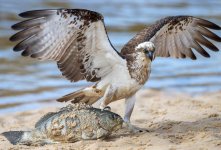Joern Lehmhus
Well-known member
Barracuda are a heavier set fish than long-finned (or yellowfin) pike, so I doubt that is the fish in the first post.
Yellowfin pike as far as I know, and a fair sized one at that - Dinolestes lewini
https://en.m.wikipedia.org/wiki/Long-finned_pike
Chosun :gh:
It depends on the Barracuda species . Australian barracuda is a more slender species than most
https://en.wikipedia.org/wiki/Australian_barracuda
https://en.wikipedia.org/wiki/Australian_barracuda#/media/File:SphyraenaNovaehollandRLS.jpg
and the fish in that photo has a short anal fin, while dinolestes lewini has a long anal fin:
https://www.meerwasser-lexikon.de/img2/30273_rrwZSbbWz5.jpg
also D. levini is not slender enough. and yello coloration of caudal fin schould extend onto the body of D. lewini.
This is not the case here.
Therefore that fish should be Sphyraena novaehollandiae








